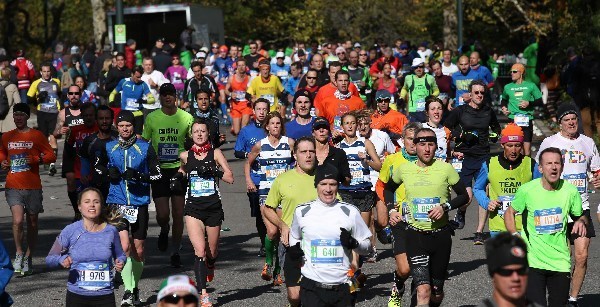 |
|
Professional atheletes and tourists from around the world compete in a New York marathon. [Photo provided to China Daily] |
Long-distance running has become a craze among the increasingly affluent and health-conscious Chinese people.
It has become a daily scene these days to see men and women, especially the young and middle-aged, jog along the streets or in parks after work or during weekends. At Beijing's Olympic park, which I often visit, runners are hot on the heels of each other, soaked with sweat and beaming with vigor and vitality. You cannot help but join them.
Though around 60 marathons were officially held or are planned for this year, as compared to a dozen several years ago, runners still find it hard to secure a place in some of the most coveted races. The upcoming Beijing marathon, for example, drew more than 60,000 applicants although only 30,000 places were available. Those who won the slot through a lottery are considered extremely lucky.
It is estimated that around 150,000 people stood at the starting line of marathons in China last year, 20 times more than a decade ago. Accompanying the exploding number of marathon runners are business opportunities and benefits that are yet to be fully tapped in China.
Marathons mean money. According to Greater Boston Convention & Visitors Bureau, the world's most prestigious race and related events brought an estimated $180 million in additional spending to Boston this year.
This included spending by participants and their guests, spectators and charity fundraising. The sports and fitness expo held alongside the Boston marathon has become the running industry's premier show for new products and services, and attracted more than 200 exhibitors and 100,000 visitors in April.
The accommodation and catering sectors are always among the main beneficiaries of a marathon. According to a survey conducted after the London marathon in 2011, about 70 percent of businesses on the marathon route were busier than on a normal day, while 76 percent felt that the marathon had a positive effect on trade. A third of pubs along the route reported that the marathon Sunday was their "busiest day of the year", while more than two-thirds of route-side convenience stores were busier than on a typical Sunday.
In comparison, the Beijing marathon, which is of a similar size as the Boston race in terms of participants, has a lot more to learn from its foreign peers. No official survey has been conducted regarding the economic benefits to be brought by the race. It was only last year that a sports expo was held at the site where participants claimed their bib number, but on a very small scale, with only a limited number of brands and products on display.
Some marathon runners say the sport is so welcome because it is simple and almost free. All you need is a pair of shoes, and you can even run without them. But is this really true?
Join a marathon and you may find it's more like a fashion show, where runners, in a desperate attempt to improve their results and show off their personality, don the most trendy and high-tech gear such as running shoes, leggings, T-shirts, shorts, socks and jackets of all colors and designs. London marathon runners spend an average of 450 pounds ($688) on running shoes, kit and training. As a rookie who started running just three years ago, the amount I spend on gear is just a quarter of that figure. But surely I am ready to splurge more, just like the others.
Those who are tech-savvy are usually equipped with watches that can update your speed and distance, heart rate and calories, with high-end devices being able to upload your statistics to an online training log where you can analyze your performance after a race. Gamin, Sunnto and Magellan are the favorite brands.
For trail runners, those who prefer to run in the mountains rather than on city streets, a pair of walking sticks, a hydration pack, a nutrition belt, a reflective race vest and a head lamp are a must and will always come in handy to boost performance, with brands such as Black Diamond, Ultimate Direction, Nathan, Salomon and Petzl, to name but a few, being the favorites.
Also on the list are knee and ankle supports, sunglasses, headgear, running hats, energy bars and gels, and so on. It actually spreads throughout an entire running industry chain.
Yet almost all these products, especially those high-end brands that are eagerly sought after by an increasing number of Chinese long-distance runners, are from overseas.
Unlike the general sports sector where you could feel the rising might of Chinese brands such as Li-Ning, Anta, 361, Peak, which are eating into the market share of world sportswear giants like Nike and Adidas, in the endurance sports sector, Chinese brands' presence is almost invisible. Winning even a tiny market share can mean immense business benefits for domestic sports firms.
But so far it seems that few if any Chinese brands have looked into this largely ignored sector - a gold mine yet to be explored.
Contact the writer at huangxiangyang@chinadaily.com.cn
(China Daily 09/08/2015 page14)